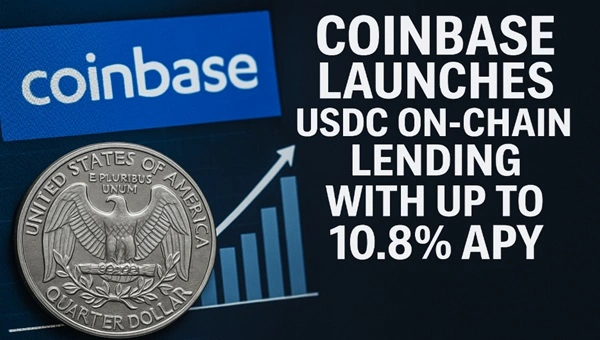


On September 18, 2025, Coinbase introduced a USDC lending product embedded directly in its app. Instead of simply holding USDC in a wallet or earning passive “USDC Rewards” (which offer up to 4.5 % for Coinbase One members), users can now deposit USDC and have it routed through on-chain vaults managed by Steakhouse Financial and powered by the Morpho protocol.
The vaults run on Base, Coinbase’s Layer 2 network, and channel deposits into open lending markets. Interest starts accruing as soon as funds are placed. Users can withdraw at any time, so long as liquidity is available, with no mandatory lock-up period
Coinbase’s USDC Rewards program has long been its way of offering yield to users who hold USDC. That program gives up to 4.1 % APY, or 4.5 % for One-membership users.
The new on-chain lending option more than doubles those returns in some cases.
By contrast, many traditional savings accounts or short-term stablecoin products in CeFi offer rates well under 5 % (often between 0.5 and 2 %), especially in regulated jurisdictions. DeFi platforms have offered higher yields before, but Coinbase’s launch makes such yields accessible without needing to self-custody or manage multiple protocols.
At launch, users in the United States (with New York excluded), Bermuda, Hong Kong, the UAE, New Zealand, the Philippines, Taiwan, and South Korea can access the feature. Broader availability is expected shortly.
The rate of “up to 10.8 % APY” is variable. It depends heavily on supply and demand in the lending markets connected through Morpho, vault utilization, and liquidity of the underlying USDC pools. Users should expect fluctuations in yield over time.
DeFi Mechanics Behind the Scenes
When a user opts into this feature, Coinbase creates a smart-contract wallet on Base. Deposited USDC is then routed into Morpho-managed vaults that are curated by Steakhouse Financial. The vaults spread deposits across lending markets to optimize returns. Borrowers include those using Coinbase’s crypto-backed loan services.
Morpho is a well-known DeFi lending protocol; its total value locked (TVL) has been reported at more than USD 8 billion.
Coinbase positions this as building a full-on-chain lending and borrowing ecosystem: depositing USDC becomes a way to both support borrowers and generate yield, all within the Coinbase app.
Key Risks and Important Caveats
Despite the high returns, some risks are inherent:
- Liquidity risk: Even though withdrawals are permitted, if many users request exit at once or if market conditions limit liquidity in vaults, delays or restrictions may occur.
- Smart contract risk: DeFi protocols are exposed to potential bugs, exploits, or security issues; Morpho vaults and their curation by Steakhouse must maintain strong security audits.
- Variable yield risk: The “up to 10.8 %” is not fixed; market dynamics may push yields significantly lower.
- Regulatory and regional restrictions: Exclusion of certain states or regions (such as New York) reflects local regulatory constraints; future policy or legal changes could affect availability.
Implications for USDC, DeFi, and Coinbase Strategy
This launch could mark a turning point for user adoption of DeFi via centralized platforms. Coinbase bridges the gap between conventional exchange/trusted interfaces (CeFi) and decentralized finance tools, lowering friction for users who previously hesitated to enter DeFi.
USDC itself continues growing in importance: with over USD 73 billion in circulation, stablecoin holders are increasingly looking for yield beyond just parking value.
For Coinbase, this is also strategic. By expanding its yield offerings, it may attract more capital inflows, deepen customer engagement, and better compete with DeFi-native platforms that have long offered high yields (with higher risk) but demanded more technical engagement.
What to Watch Next
The product’s trajectory will be shaped by factors such as APY movements, security outcomes, liquidity strength under market stress, and regulatory decisions in jurisdictions debating yield frameworks. Another consideration is whether Coinbase introduces comparable offerings for other stablecoins or assets..
Parting Shot
The launch of USDC on-chain lending at rates up to 10.8% APY positions Coinbase to bridge centralized platforms with DeFi opportunities. Convenience, competitive yields, and international availability strengthen the case for adoption. At the same time, unstable APYs, liquidity stress, and possible regulatory pushback pose challenges. The feature stands out for its reward potential, but exposure to risk remains central.
He has worked with several companies in the past including Economy Watch, and Milkroad. Finds writing for BitEdge highly satisfying as he gets an opportunity to share his knowledge with a broad community of gamblers.
Nationality
Kenyan
Lives In
Cape Town
University
Kenyatta University and USIU
Degree
Economics, Finance and Journalism


Facts Checked by Maryam Jinadu

 Fact checked by
Fact checked by 
 eabungana@gmail.com
eabungana@gmail.com 